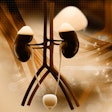CHICAGO - Patients who were treated with intravenous acetylsalicylic acid, commonly known as aspirin, had significantly reduced thromboembolic events when doctors attempted to perform embolization of cerebral aneurysms, according to a study presented at the 2006 RSNA meeting.
Thromboembolic event rates were halved among the 159 aneurysms in patients treated with acetylsalicylic acid compared to the 102 aneurysms in patients treated without the antiplatelet agent, the study authors reported on Thursday.
"Intravenous application of acetylsalicylic acid is feasible and safe during interventional aneurysm embolization," said Thorsten Ries, a neuroradiologist at the University Medical Center Hamburg-Eppendorf in Germany.
Ries reported on the treatment of 247 patients who presented with 261 aneurysms that doctors attempted to close using interventional rather than surgical methods. The study included 102 aneurysms treated between 2001 and 2003 without the use of intravenous acetylsalicylic acid. From January 2003 to September 2004, the doctors treated 159 aneurysms with 250 mg of intravenous acetylsalicylic acid included.
The researchers found that thromboembolic events during the procedure occurred in 18 of the 102 aneurysm embolizations attempted without acetylsalicylic acid -- a rate of 17.6%. Among the patients treated with acetylsalicylic acid, 14 thromboembolic events occurred among the 159 aneurysm coil embolization procedures -- a rate of 8.8%. That difference in event rate reached statistical significance at the p = 0.028 level, Ries said in his presentation.
"Intravenous acetylsalicylic acid seems to be associated with a significant reduction in the rate of thromboembolic events without increase in the rate or severity of intraoperative bleeding," he said.
"Intravenous aspirin is not approved by the Food and Drug Administration for use in the United States," said Dr. Christopher Dowd, an associate professor of radiology at the University of California, San Francisco, and the session moderator. "We wish we had it."
"This study showed that aspirin can reduce events by half. That is impressive. It may seem counterintuitive that we would give aspirin, which is designed to prevent clotting, when we want to clot off another blood vessel," he said.
"I liken it to driving with one foot on the brake and one foot on the gas," Dowd said. The idea is to use aspirin to prevent inappropriate clotting, while the embolization coils perform their job in clotting the aneurysm. "We don't want the healthy blood vessels to clot, and we use aspirin to prevent that."
Aspirin administered orally or rectally provides similar antiplatelet protection as the intravenous form of the drug, Dowd said.
By Edward Susman
AuntMinne.com contributing writer
December 1, 2006
Related Reading
CTA equivalent to angiography for detecting brain aneurysms, April 25, 2006
Perfusion CT, MRI agree on most stroke parameters, June 1, 2005
Flat position improves blood flow in stroke patients, May 6, 2005
Cerebral blood MRI confirms stroke reperfusion success, April 19, 2005
Postprocessing reveals earliest signs of cerebral infarct on plain CT, March 5, 2005
Copyright © 2006 AuntMinnie.com



















